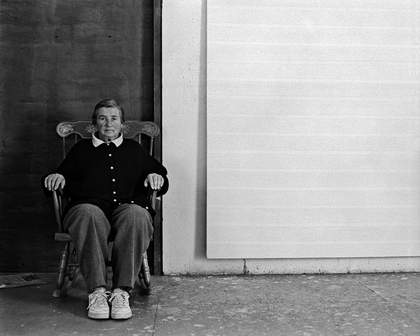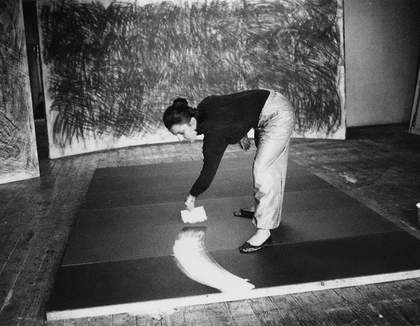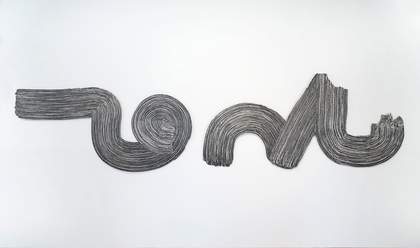
Agnes Martin in her studio in New Mexico, 1992, photographed by Charles Rushton
Photograph © Charles Rushton, courtesy Charles Rushton
When Agnes Martin declared in a packed Pasadena lecture hall: ‘Artists have to be lonely,’ I spoke up and said: ‘Agnes, all you have to do is pick up the telephone.’ She turned to my familiar voice and replied: ‘MaryRose (transposing my name), did you come here to bug me?’ I laughed, since years earlier, in 1977, when I was visiting Agnes in Boulder, Colorado, I missed her call.
She had sent me a postcard telling me when she would place the call, as she had to drive sixteen miles to town to do so. I was conducting a symposium at that moment in Boulder and couldn’t be home next to a phone. Waiting for the spring break, I set out in a 1954 Chevy bought for the occasion, dog and bicycle in tow, to track her down according to the map she drew for me a few years earlier when she set off westward-ho in an old jeep. She confessed to me that she had stopped painting and just ‘made garages’. I told her she was making sculpture in her homesteading endeavours. The map showed a few forks in the canyon road, but when I got to the area, there were quite a few more with skeletal cow remains as secret signposts. The sun was setting and I backed out of the canyon, went into town and sent her a postcard from Cuba, New Mexico.

Photograph from Rosemarie Castoro’s Journal, 1970-71
© Rosemarie Castoro, courtesy Broadway 1602, New York
I had met Agnes in her studio in the late 1960s. We were both painters who made ‘paste-ups’ for a living, with triangles and T-squares on drafting boards as our tools in trade. I was using Prismacolor pencils at the time, cutting out huge triangles from cardboard to make multichrome paintings, and the straight edge of the canvas stretchers as my ‘drafting table’. Back then painters had a camaraderie, meeting through other painters. Often we would meet at bars, or visit each other’s studios for tea.

Rosemarie Castoro
Guinness Martin 1972
Masonite, gesso, graphite and modelling paste, 914 x 4572mm
© Rosemarie Castoro, courtesy Broadway 1602, New York
In 1972 I made a ‘cut-out’ brush work for Agnes which was part of a series of wall sculptures created with a non-art brush – this one was a large broom – that spelled out her name in Pitman shorthand. I had made a series of these portraits based on friends’ names. ‘Guinness Martin’ came about as a disguise of Agnes’s name.
